neutral; feeds on nest debris
Acarus Linnaeus, 1758
Superorder Acariformes » Order Sarcoptiformes » Suborder Oribatida » Infraorder Desmonomata » Hyporder Astigmata » Family Acaridae » Genus Acarus
Acarus siro [var.] farinae Linnaeus, 1758 (=Acarus siro Linnaeus, 1758 as selected by Latreille, 1810)
Tyroglyphus Latreille, 1796; Aleurobius Canestrini, 1888 (common historical synonyms)
flour mite (Acarus siro)
Adult: Bell-shaped structure present at entrance of canal of spermathecaspermatheca:
A structure in the female for storing sperm, typically sac-like.
in female (Fig. 11). Male with leg I enlarged and bearing a ventral apophysis (external projection from body wall) on femurfemur:
Leg or palp segment (also known as podomere or palpomere) between genu and trochanter. In ParasitIformes can be subdivided into telofemur and basifemur.
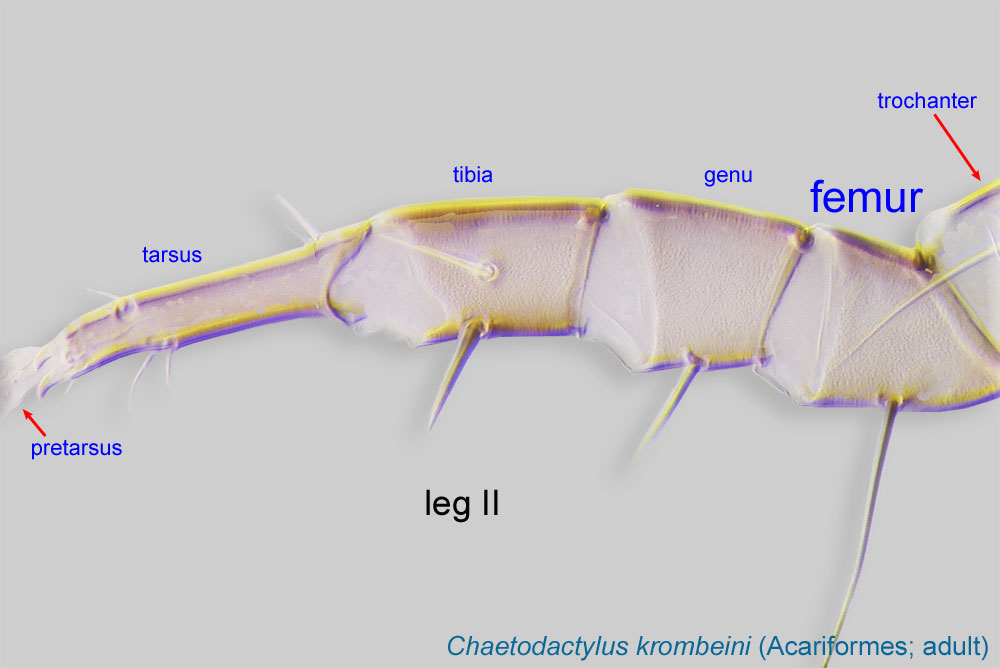 (Fig. 14).
(Fig. 14).
Phoretic phoretic:
Pertaining to phoresy; using another organism (i.e., a host) for dispersal to new habitats. Phoresy can be distinguished from parasitism because feeding typically does not occur during phoresy.
deutonymph: Tarsal setae aa I, ba II present (Fig. 3). Seta ba I absent (Fig. 3). Solenidionsolenidion:
Thin-walled, terminally rounded or pointed filiform or peglike structure that is not birefringent in polarized light (unlike common setae in Acariformes). Often appears striated because of its internal structure. Found on the palpal tarsus on the gnathosoma and may also occur on the tarsus and tibia, less frequently on the genu, and occasionally on the femur of legs I-IV. In Acariformes, leg solenidia often arise from unsclerotized areas.
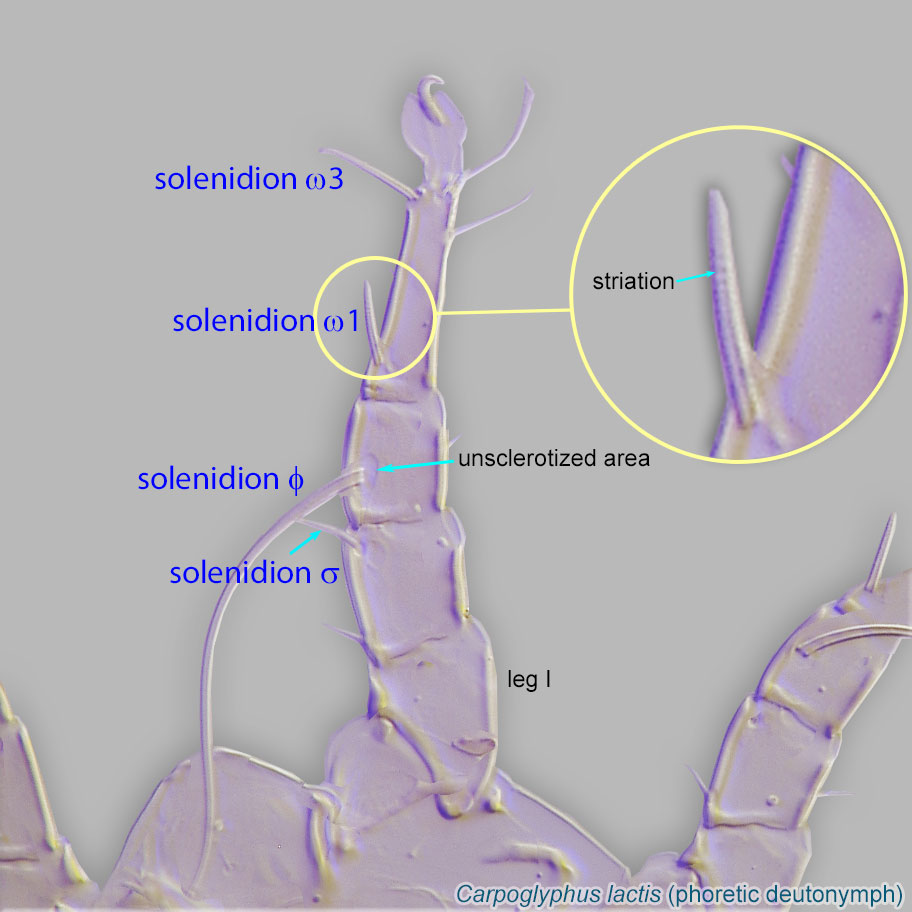 ω3 of tarsustarsus:
ω3 of tarsustarsus:
Terminal segment (also known as podomere or palpomere) of legs or palps. In Parasitoformes it can be subdivided into telotarsus and basitarsus.
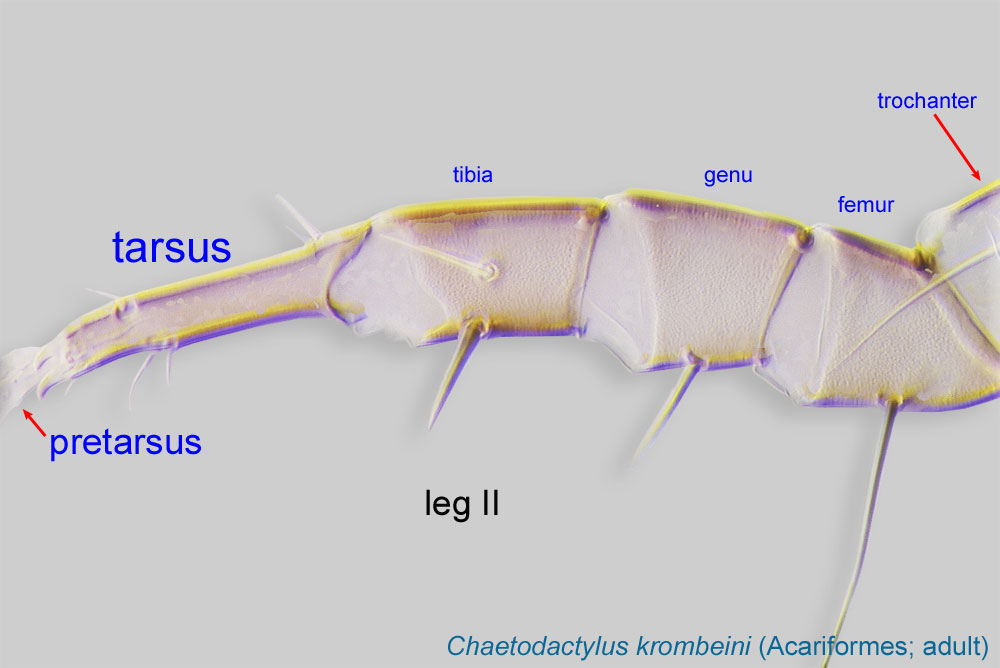 I situated in the middle of the tarsustarsus:
I situated in the middle of the tarsustarsus:
Terminal segment (also known as podomere or palpomere) of legs or palps. In Parasitoformes it can be subdivided into telotarsus and basitarsus.
 , disassociated with ω1 (Fig. 3). Dorsal body surface with rounded depressions (Fig. 3). External conoidal setae ps2 of attachment organattachment organ:
, disassociated with ω1 (Fig. 3). Dorsal body surface with rounded depressions (Fig. 3). External conoidal setae ps2 of attachment organattachment organ:
Complex unpaired structure in phoretic deutonymphs of Astigmata situated on the posteroventral end of the body that serves for attachment to the host during phoresy. In deutonymphs phoretic on insects, attachment organ consists of a vestigial anal opening and two types of attachment elements: true suckers that create negative pressure and conoids that create adhesive forces. Not to be confused with pedicel.
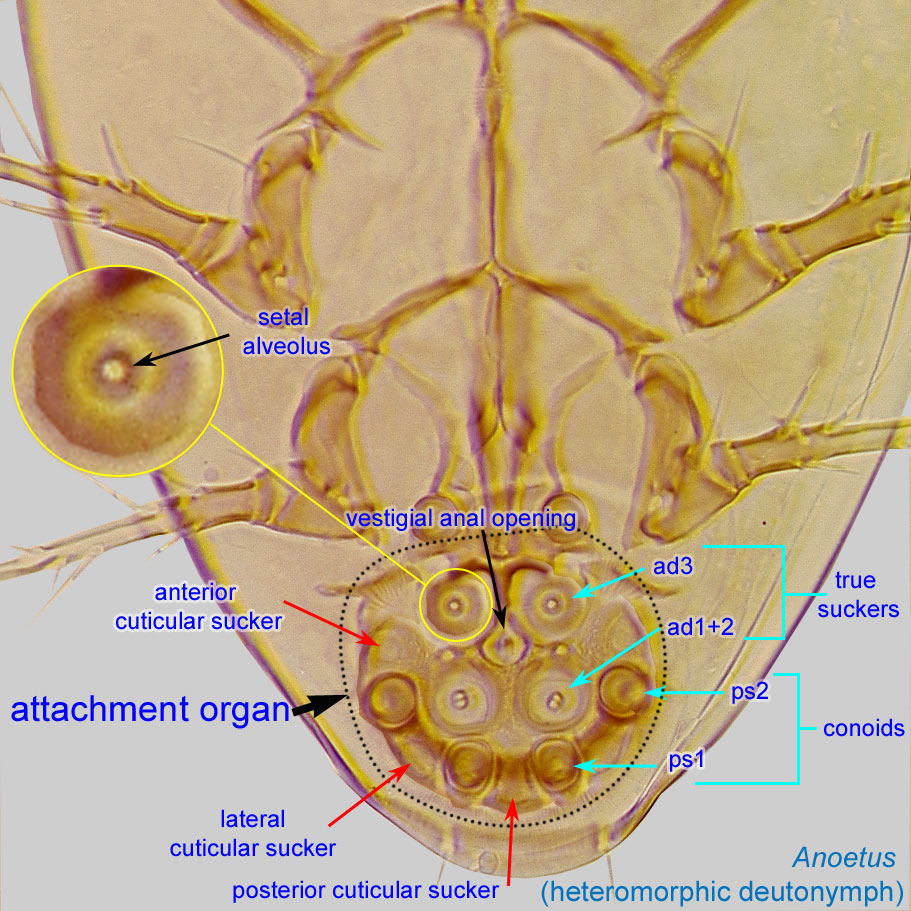 lateral to median sucker (ad1+2) (Fig. 5). Sternal apodemeapodeme:
lateral to median sucker (ad1+2) (Fig. 5). Sternal apodemeapodeme:
Internal sclerite that serves as an attachment site for muscles. Most commonly used (as "coxal apodeme") to describe elements of coxae fused to the ventral body in Acariformes (coxae are free and not fused to the body in Parasitiformes), and may be variously referred to as ventral, sternal, anterior, or posterior.
 and anterior apodemesapodeme:
and anterior apodemesapodeme:
Internal sclerite that serves as an attachment site for muscles. Most commonly used (as "coxal apodeme") to describe elements of coxae fused to the ventral body in Acariformes (coxae are free and not fused to the body in Parasitiformes), and may be variously referred to as ventral, sternal, anterior, or posterior.
 II not extending to level of coxal apodemesapodeme:
II not extending to level of coxal apodemesapodeme:
Internal sclerite that serves as an attachment site for muscles. Most commonly used (as "coxal apodeme") to describe elements of coxae fused to the ventral body in Acariformes (coxae are free and not fused to the body in Parasitiformes), and may be variously referred to as ventral, sternal, anterior, or posterior.
 III. Setae of coxal fields I and III present, but very fine and short (Fig. 2). Empodial clawsEmpodial claw:
III. Setae of coxal fields I and III present, but very fine and short (Fig. 2). Empodial clawsEmpodial claw:
Claw-like, membranous, or pad-like structure of setal origin. Present only on the pretarsus in Acariformes. In Astigmata, it is the only claw on the pretarsus and often referred to simply as the claw. In the remaining Acariformes, may be accomanied by two lateral claws. Also known as empodium, pretarsal empodium, or central claw.
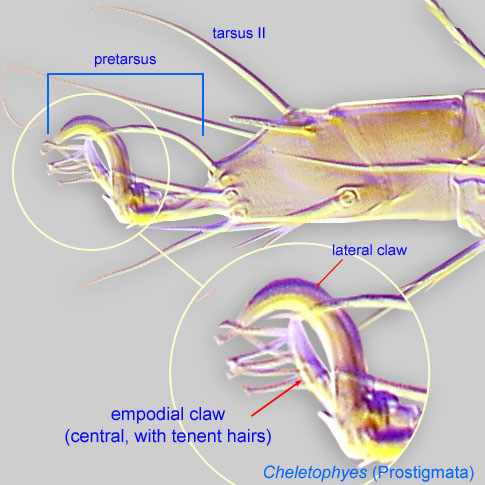 of pretarsipretarsus:
of pretarsipretarsus:
Terminal leg or palpal segment distal to tarsus.
III-IV similar in form (Fig. 5). Solenidionsolenidion:
Thin-walled, terminally rounded or pointed filiform or peglike structure that is not birefringent in polarized light (unlike common setae in Acariformes). Often appears striated because of its internal structure. Found on the palpal tarsus on the gnathosoma and may also occur on the tarsus and tibia, less frequently on the genu, and occasionally on the femur of legs I-IV. In Acariformes, leg solenidia often arise from unsclerotized areas.
 ω2 of tarsustarsus:
ω2 of tarsustarsus:
Terminal segment (also known as podomere or palpomere) of legs or palps. In Parasitoformes it can be subdivided into telotarsus and basitarsus.
 I absent, represented by vestigial alveolus (Fig. 3). Setae gT I-II and hT I-II distinctly barbed (Fig. 4). GenuaGenu:
I absent, represented by vestigial alveolus (Fig. 3). Setae gT I-II and hT I-II distinctly barbed (Fig. 4). GenuaGenu:
Leg or palp segment (also known as podomere or palpomere) between tibia and femur.
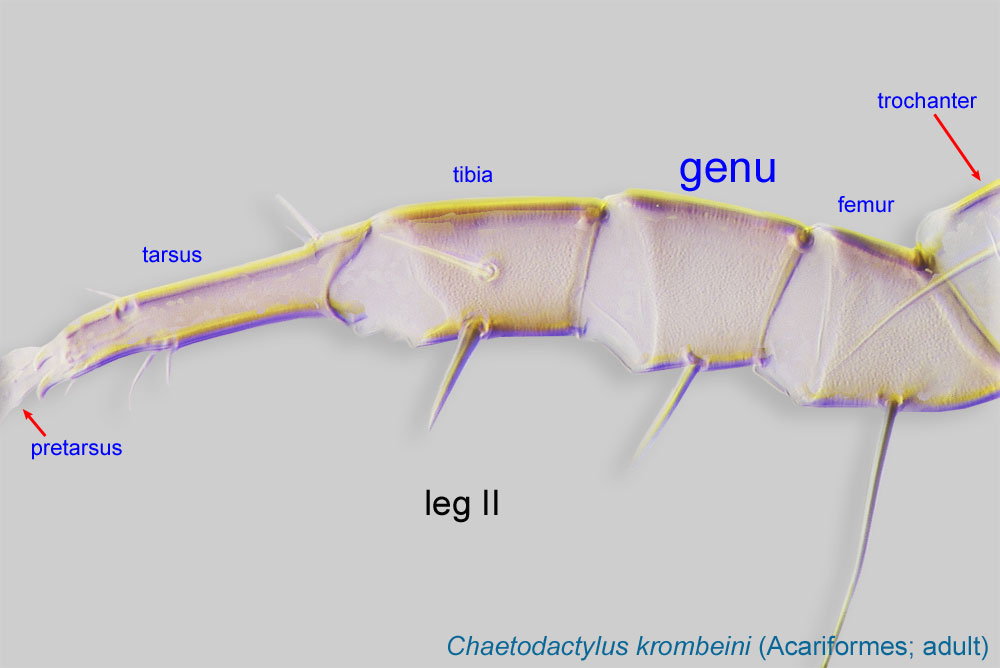 III-IV subequal to tibiaetibia:
III-IV subequal to tibiaetibia:
Leg or palp segment (also known as podomere or palpomere) between tarsus and genu.
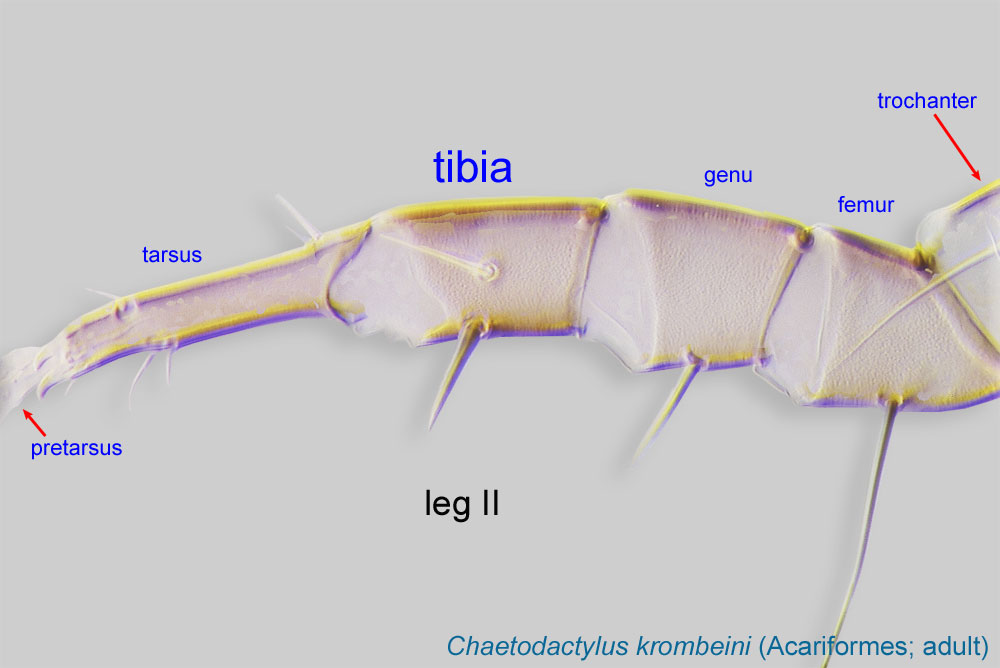 III-IV (Fig. 5). Genugenu:
III-IV (Fig. 5). Genugenu:
Leg or palp segment (also known as podomere or palpomere) between tibia and femur.
 III without a short dorsal solenidionsolenidion:
III without a short dorsal solenidionsolenidion:
Thin-walled, terminally rounded or pointed filiform or peglike structure that is not birefringent in polarized light (unlike common setae in Acariformes). Often appears striated because of its internal structure. Found on the palpal tarsus on the gnathosoma and may also occur on the tarsus and tibia, less frequently on the genu, and occasionally on the femur of legs I-IV. In Acariformes, leg solenidia often arise from unsclerotized areas.
 (σ) in addition to seta nG (Fig. 5).
(σ) in addition to seta nG (Fig. 5).
Adult: Setae ve situated between the level of internal vertical setae (vi) and one-third the distance to scapular setae (se, si) (Fig. 10). Grandjean's organ complex, multifurcate (Figs. 10, 12). Genugenu:
Leg or palp segment (also known as podomere or palpomere) between tibia and femur.
 I with solenidionsolenidion:
I with solenidionsolenidion:
Thin-walled, terminally rounded or pointed filiform or peglike structure that is not birefringent in polarized light (unlike common setae in Acariformes). Often appears striated because of its internal structure. Found on the palpal tarsus on the gnathosoma and may also occur on the tarsus and tibia, less frequently on the genu, and occasionally on the femur of legs I-IV. In Acariformes, leg solenidia often arise from unsclerotized areas.
 σ' more than 3 times longer than σ'' (Fig. 13). Ventral apex of tarsustarsus:
σ' more than 3 times longer than σ'' (Fig. 13). Ventral apex of tarsustarsus:
Terminal segment (also known as podomere or palpomere) of legs or palps. In Parasitoformes it can be subdivided into telotarsus and basitarsus.
 I with proral (p, q) setae thin (Fig. 12), and unguinal (u, v) setae short, stout spines (Figs. 12, 13).
I with proral (p, q) setae thin (Fig. 12), and unguinal (u, v) setae short, stout spines (Figs. 12, 13).
A dichotomous key is available in Griffiths, 1970Griffiths, 1970:
Griffiths, D. A. 1970. A further systematic study of the genus Acarus L., 1758 (Acaridae, Acarina), with a key to species. Bulletin of the British Museum (Natural History) Zoology.19: 85-118.. Although new species have been described since 1970, this key can be used to identify all known species found in association with bees.
The genus is cosmopolitan. Records from bees are from the Palaearctic and Oriental regions.
Adults live in a variety of habitats, including bee nests (Apis and Bombus).
facultativefacultative:
can complete entire life cycle without bees or their close relative, wasps
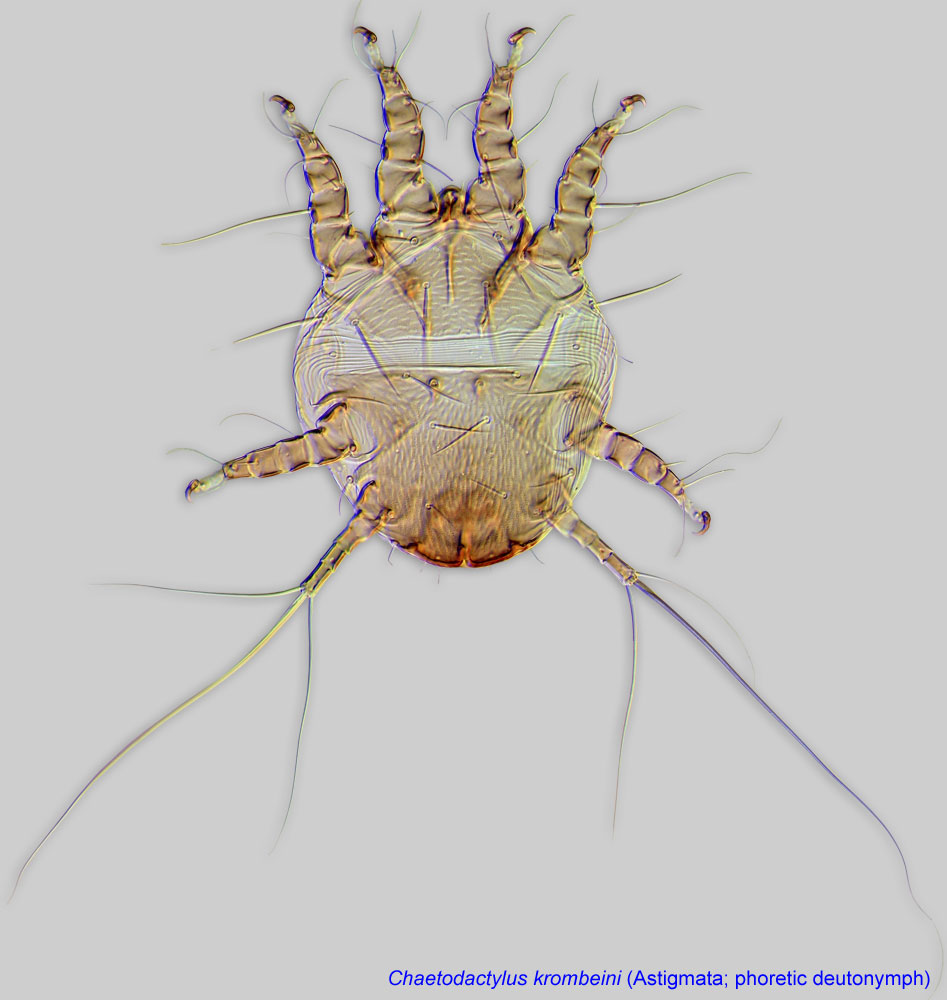 opportunistically attach to any arthropod carrier they can find nearby and use it for dispersal to a new habitat. Phoresyphoresy:
opportunistically attach to any arthropod carrier they can find nearby and use it for dispersal to a new habitat. Phoresyphoresy: that can survive in adverse conditions.
that can survive in adverse conditions.The genus Acarus includes species that primarily inhabit nests of warm-blooded animals: mostly rodents and birds, but they are also peridomesticperidomestic:
Of or pertaining to living in or around human habitations.
. These species are serious pests of stored products, primarily infesting grain and flour. Some species infest cheese (Fig. 15). Phoreticphoretic:
Pertaining to phoresy; using another organism (i.e., a host) for dispersal to new habitats. Phoresy can be distinguished from parasitism because feeding typically does not occur during phoresy.
hosts include various arthropods (e.g., beetles, flies, fleas, and large mites).
Five species have been recorded from nests of European honey bee (Apis mellifera): Acarus farris, Acarus gracilis, Acarus immobilis, Acarus siro, and Acarus tyrophagoides. In addition, Acarus siro has been found in nests of Apis cerana and Bombus pascuorum. Acarus farris was the third most common species of Astigmata found in beehives in Poland (after Glycyphagus domesticus and Carpoglyphus lactis). In beehives Acarus species prefer pollen and bee bread, followed by bee hive debris. More rarely Acarus species occur on combs, wax, dead brood and bees, and mold. A few species can reproduce on propolispropolis:
A red or brown resinous substance collected by honey bees from tree buds that is used by them to fill crevices and to seal and varnish honeycombs.
(A. immobilis) and honey (A. siro) but none on royal jelly (Chmielewski, 1991cChmielewski, 1991c:
Chmielewski, W. 1991c. Stored products mites (Acaroidea) in Polish bee hives. In Modern acarology. Volume I: proceedings of the 8 International Congress of Acarology, held in Ceske Budejovice, Czechoslovakia, 6-11 August 1990. , 615-619. The Hague, The Netherlands: SPB Academic Publishing.).